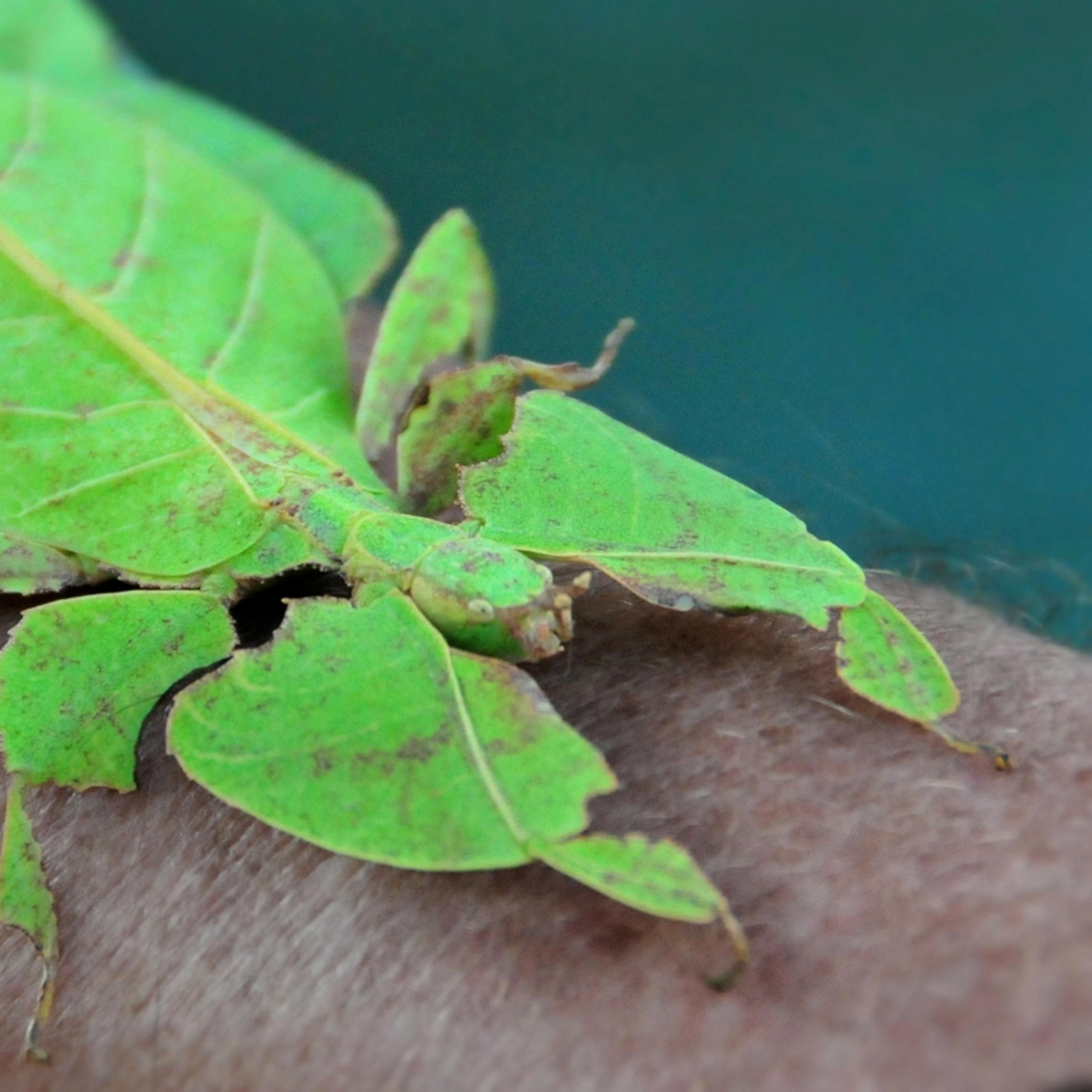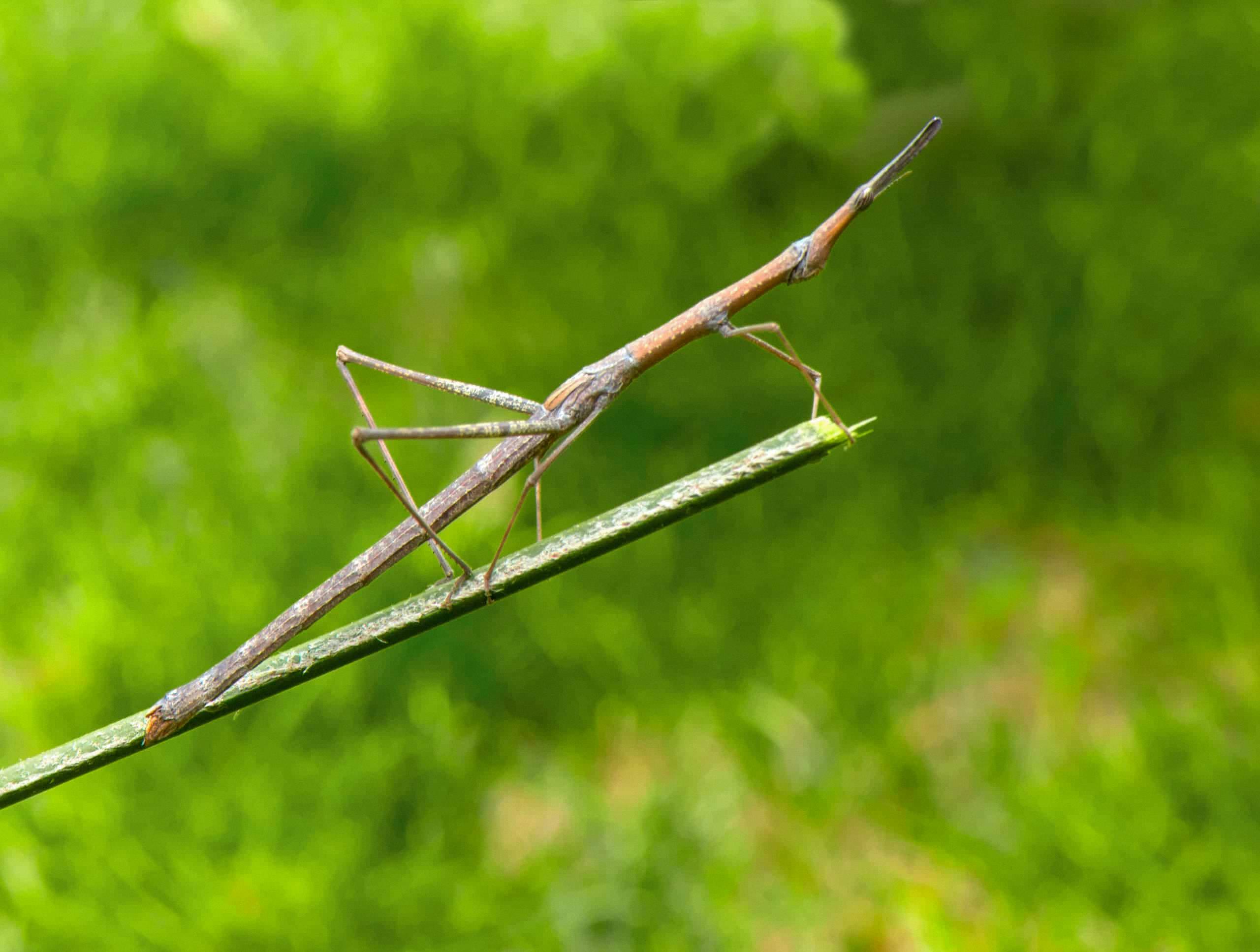Walking sticks are fascinating creatures that are often admired for their unique appearance and behavior. One question that many people may have about these insects is whether or not they bite. The short answer is that walking sticks are not known to bite humans, but there are a few things to keep in mind when handling them.
Walking sticks, also known as stick insects, are usually harmless to humans. They have long, slender bodies that proide excellent camouflage, helping them blend in with their surroundings. They feed on leaves and other vegetation and are generally not aggressive towards humans. In fact, they are incredibly docile and can be easily handled without any risk of being bitten.
However, there are a few species of walking sticks that have defensive mechanisms that can cause harm to predators. For example, the American stick insect (Anisomorpha buprestoides) found in the southeastern United States can spray a milky, acidic compound from glands on the back of its thorax. This spray is not harmful to humans but can cause irritation or a burning sensation if it comes into contact with the skin or eyes.
In addition to their defensive spray, walking sticks also have other ways of protecting themselves from predators. Some species have sharp spines on their legs that can inflict pain on an attacker, while others may emit a chemical spray similar to tear gas.
Despite these defensive mechanisms, walking sticks are generally harmless to humans and are not known to bite. They are incredibly delicate creatures, and care should be taken when handling them. They can be easily stressed, and rough handling or accidental drops can cause injury or even death.
Walking sticks are fascinating insects that are generally harmless to humans. While some species have defensive mechanisms that can cause harm to predators, they are not known to bite humans. If you are interested in observing or handling walking sticks, it is important to do so with care and respect for these delicate creatures.
Can Walking Stick Bugs Cause Harm to Humans?
Walking stick bugs, also known as stick insects, are generally considered harmless to humans. They do not possess any venom or poison that could cause harm to humans. However, some species of stick insects have spines on their legs that they may use to defend themselves. These spines can cause a slight prick or scratch, but they are not harmful to humans. Additionally, some stick insects may emit a chemical spray when threatened, whch has a similar effect to tear gas. While this spray may cause discomfort, it is not dangerous to humans. In summary, while walking stick bugs may have methods of defense, they are not capable of hurting humans.

Source: kids.nationalgeographic.com
Are Walking Sticks Dangerous?
Walking sticks are generally not poisonous and do not bite humans. However, some species, such as the American stick insect, found in the southeastern United States, can spray a milky, acidic compound from glands on the back of its thorax when threatened. This acidic compound can cause skin irritation or even blistering in some individuals. Therefore, it is important to handle walking sticks with care and avoid provoking them. Overall, while walking sticks may not be dangerous, it is always best to exercise caution around any wild animal.
Does a Walking Stick Have a Stinger?
No, a walking stick does not have a stinger. While their tail may resemble that of a scorpion, it does not possess a venomous stinger. Instead, walking sticks use their tails for balance and to deter predators. Walking sticks have other unique adaptations, such as claws and suction pads on their feet that allow them to climb, and males have wings that enable them to fly.
The Friendliness of Walking Sticks
Yes, walking sticks or stick insects are generally considered to be friendly and docile creatures. They are not aggressive and do not pose any harm to humans. In fact, they are often kept as pets due to their calm nature and ease of care. Walking sticks are not known to bite or sting, and they will uually just walk around on your hand without any fuss. However, it is important to handle them gently as they are delicate creatures and can be easily injured. So, while walking sticks may not be social animals like dogs or cats, they can still make for interesting and low-maintenance pets.
The Touchability of Stick Insects
Yes, you can touch a stick insect, but it is important to do so carefully and gently. Stick insects, also known as phasmids, have delicate bodies and limbs that can break easily if handled improperly. It is best to avoid picking them up or holding them if possible. Instead, you can encourage the stick insect to walk onto your hand by gently placing your hand in front of it and letting it climb onto you. It is important to avoid squeezing or pinching the insect, as this can case it harm. Additionally, it is important to wash your hands before and after handling a stick insect to avoid transferring any harmful substances or bacteria to the insect or from the insect to yourself.

Source: a-z-animals.com
Are Stick Bugs a Friendly Species?
Stick insects, also known as stick bugs, can be considered friendly pets. They are generally docile and do not exhibit aggressive behavior towards humans. However, it is important to handle them with care as they are fragile creatures and can be easily injured if mishandled. Stick insects are known to enjoy being handled and may even crawl onto your hand willingly. Some species of stick insects, such as the Indian stick insect, have been known to be social and interact with their owners. Overall, stick insects can make great pets for those who are gentle and patient with them.
The Role of Blood in Walking Sticks
Yes, walking sticks have a circulatory system and therefore have a fluid that can be compared to blood. The fluid is called hemolymph and it serves a similar function to blood in other animals, such as transporting nutrients, oxygen, and waste products throughut the body. However, hemolymph differs from blood in that it does not contain red blood cells or hemoglobin. Instead, it contains a colorless fluid called plasma and various types of cells, including hemocytes which play a role in the insect’s immune system. So, while walking sticks do not have blood in the traditional sense, they do have a fluid that performs similar functions in their body.
The Potential Dangers of Walking Sticks: Is There a Poisonous Variety?
The walking stick that has the ability to produce and shoot poison is known as the Southern Two Striped Walkingstick. This insect is equipped with specialized glands located behind its head that contain a toxic substance that can be expelled towards a predator. This poison is usually aimed towards the eyes of the attacker and can cause severe irritation, pain, and even temporary blindness. It is important to note that not all walking sticks are poisonous, and it is always best to observe and appreciate them from a safe distance to avoid any potential harm.
Getting Rid of Walking Stick Bugs
To successfully get rid of walking stick bugs, you need to take a multi-pronged approach. Here are some effective methods:
1. Handpicking: Walking stick bugs are slow-moving insects, making them easy to spot and pick off by hand. This method works best for small infestations.
2. Vacuuming: Use a handheld vacuum to suck up the walking stick bugs from the plant. Be sure to empty the vacuum ouside to prevent the bugs from crawling back out.
3. Neem oil: Neem oil is an effective insecticide that repels and kills walking stick bugs. Mix 2 tablespoons of neem oil with 1 gallon of water and spray the solution on the affected plant.
4. Insecticidal soap: Insecticidal soap is a natural insecticide that works by suffocating the bugs. Mix 2 tablespoons of insecticidal soap with 1 gallon of water and spray the solution on the plant.
5. Pyrethrin: Pyrethrin is a synthetic insecticide that is effective against walking stick bugs. Mix the recommended amount of pyrethrin with water and spray the solution on the affected plant.
6. Diatomaceous earth: Diatomaceous earth is a natural insecticide that works by dehydrating the bugs. Sprinkle a thin layer of diatomaceous earth on the plant and the surrounding soil.
It’s important to note that walking stick bugs can lay their eggs on the plant, so you may need to repeat these methods several times to completely get rid of them.

The Rarity of Walking Stick Bugs
Stick insects, commonly known as walking stick bugs, are not considered rare insects. They are found in many parts of the world, including North and South America, Africa, Asia, and Australia. However, their cryptic appearance and slow movement make them difficult to spot in their natural habitats. As a result, people may not realize how many stick insects are arond them. Additionally, stick insects are not known for dispersing over long distances, as they are wingless and rely on camouflage to avoid predators. Therefore, it is possible that stick insects may be more common in certain areas than people realize, but they are not considered rare overall.
Are Stick Bugs a Threat to Humans?
Stick bugs, also known as phasmids, are not harmful to humans, pets, or other animals. They do not bite, sting, or attack. These insects are primarily herbivores and feed on leaves and other vegetation. Stick bugs have a unique defense mechanism were they can blend in with their surroundings by mimicking the appearance of sticks or twigs, making them difficult to spot by predators. If you happen to come across a stick bug, you can simply observe or leave them alone, as they pose no threat to you or your surroundings. Overall, stick bugs are harmless insects that play an important role in their ecosystem as herbivores and prey for other animals.
Conclusion
In conclusion, walking sticks are fascinating and unique insects that have captured the interest of many people. While they may look intimidating with their spiny legs, they are actually harmless and incredibly docile. Walking sticks are not known to bite, and even the species that can spray a milky acidic compound are unlikely to do so unless provoked. It is important to handle these delicate insects with care, as they can easily be injured or harmed. Overall, walking sticks are a safe and fascinating addition to any insect collection or nature observation.
